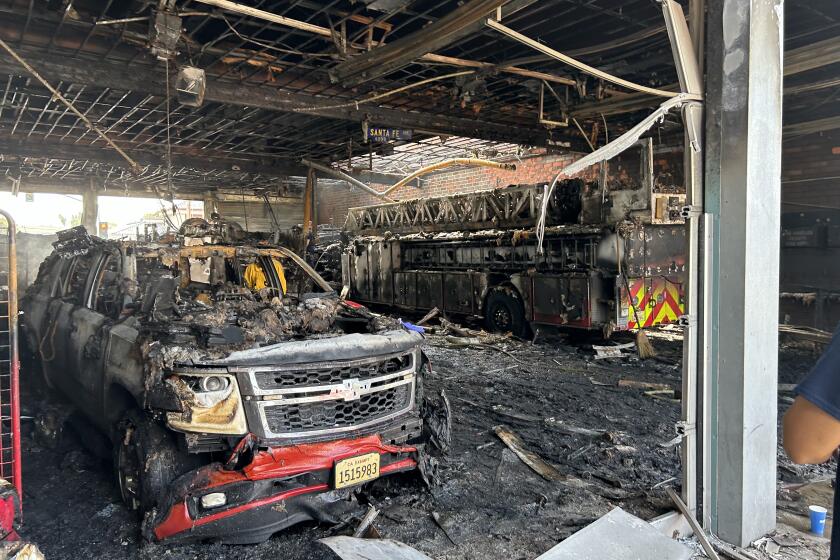Fire and Rain Lead to Dramatic New Landscape
Six thousand feet up Cuyamaca Peak, more than a month into springtime, a frigid wind blew fog around giant blackened conifers. Ice pellets clicked down through the trees’ naked boughs as Michael Wells crouched amid a scattering of second-year pine seedlings.
He had begun to wonder whether a new generation of pines could get a foothold here. Since the Cedar wildfire of 2003, low-lying chaparral had sprouted prolifically, and until this year, it was beginning to look as though it might completely replace Cuyamaca Rancho State Park’s majestic pine woodlands.
“These seedlings made it through a tough year, and now there’s a lot more water,” he said of the bristling miniatures, some of which had begun to branch outward. “It means they’ve got their roots down far already. In 10 years, they’ll be 15 or 20 feet tall, and at that point, it could start looking a little like a forest again. So, there will be some pockets of pine. I feel better now.”
Wells, a state parks official who wrote his doctoral dissertation about the pines of Cuyamaca Rancho, and others familiar with this place are speculating that this winter’s prolific rainfall may confound some of the drearier expectations about the park’s regeneration after the devastation inflicted by the fire.
“Nature is doing things differently than we supposed,” said Cuyamaca Rancho Supt. Laura Itogawa. “We know what a normal fire would do, but after a catastrophic event like this, we really don’t.”
A decade of drought had served up the park’s forest to the Cedar fire on a platter. The fire burned all but 300 of the park’s 26,000 acres. It inflicted otherworldly devastation on vast stretches, consuming every leaf, blade of grass and pebble of organic soil.
In the first year after the burn, the drought continued, sparing the newly naked landscape from mudslides, but retarding its first attempts to renew itself.
Then, this past winter, the rain came in abundance. More than 50 inches have fallen on the park, 40 miles east of San Diego, since last October -- more than 2 1/2 times the average of the previous six years. Cuyamaca Lake, which lies next to the park, contained barely 500 acre-feet of water in October but swelled to a high of 6,700 acre-feet during the winter. (An acre-foot is enough water to cover one acre to a depth of 12 inches.)
Now, water bubbles and glides in Cuyamaca Rancho’s streambeds as a million burned trees brood above. New streams and ponds have formed. Mountain meadows have gone boggy.
Here and there, amid the forest of charred conifers written off last year as fatally wounded, is one that sports an incongruous new hat of furry green.
The number of visitors to the park, which was closed for six months after the fire, is slowly picking up as major campgrounds and virtually all trails have reopened. Visitation is running at about a third of the pre-fire figure of 600,000 people a year.
But the park’s regeneration -- with the rain serving as midwife -- has come at a price. Heavy downpours washed out many of Cuyamaca Rancho’s hiking trails and fire roads. They blocked drainage culverts with silt, creating beautiful waterfalls but threatening to wash out California 79, which bisects the park.
“The forest desperately needed the water, but we did worry a lot about washouts,” Itogawa said. “What the fire didn’t do, the flooding did. We had to keep telling ourselves, ‘This is good. This is good.’ I’d rather have the rain than another drought.”
In the south end of the park, charred boulders that loomed precariously above the landscape have been washed clean, and once-ashy hillsides are now green with sprouting chaparral that will help prevent erosion.
The most gratifying result of the wet weather, Itogawa said, is that “trees we really thought were goners are coming back. The doomsayers’ predictions are not coming true. The park looks as good as it could, and not as bad as it could have.”
The water had other unanticipated effects. Given all the rain and the soil’s exposure to unimpeded sunlight since the destruction of the forest canopy, park personnel expected the most spectacular wildflower bloom in recent memory this year. The earth, however, has yet to yield it.
It’s possible that cool weather simply has delayed the bloom, but also, Wells and Itogawa said, the saturation of the park’s low-lying meadows may be interfering. “Wildflowers’ roots have to respirate, and different plants have different tolerances for being inundated,” Wells said.
“They may have gotten so used to dry weather that they’re taking the year off,” Itogawa said.
Park personnel were surprised, too, by the number of healthy-looking trees that fell during the winter as the soil turned soupy. They had expected the park’s dead trees to fall more readily than trees that survived the fire. But they found that many apparently healthy trees turned out to have internal disease and rot that caused them to topple.
The water was good for the various fungi that have taken hold on many of the dead standing trees. Their conks protrude like multiple smooth, surrealistic noses from the trees’ trunks, while their tentacles spread through the interior of the trees, digesting lignin and cellulose and subverting the trees’ structural integrity.
In time, five years or so, many of the great corpses will have fallen and been covered with grasses and other low-lying vegetation. As the trees topple, Cuyamaca Rancho will have less of a vertical aspect to draw the eye upward.
The epochal effects of the fire will play out slowly in the mix of vegetation and wildlife in the park.
Virtually all forms of mammal life, Itogawa said, have returned to the park as plant eaters find ample tender new vegetation to feed on and, in turn, draw predators.
The deer population, which was reduced by an estimated 20% during the fire, is now thought to have come back to at least its pre-fire numbers. Because of the new availability of water and palatable young plants in the park’s backcountry, however, they’re not as much in evidence in the park’s low-lying meadows and near its primary streams, where they would be more easily spotted by visitors.
Birds are the one category of wildlife in which the mix of species has been dramatically altered. Pine forest birds such as the mountain chickadee and the pygmy nuthatch, two of the most common birds in the park before the fire, have all but disappeared. Their place has been taken by open-country species, such as the lazuli bunting and rock wren, birds that nest in bushes or rock crevices rather than trees.
“Before the fire, all through the park you’d hear the ‘Mona Lisa’ song of the mountain chickadee,” said Philip Unitt, curator of birds and mammals for the San Diego Natural History Museum, who has been monitoring the park’s bird populations. “Now the song of the lazuli bunting, a rapid jumble of buzzing musical notes, is pervasive. You cannot get out of earshot of the lazuli bunting.”
As for the woodlands themselves, there are pockets of pine seedlings and individual conifers that at least for now have survived, but the stately pine forests that were Cuyamaca’s hallmark will not return for 100 years or more, if at all.
Oaks and chaparral, because they sprout from their roots (and, in the case of the former, their branches), rebound relatively easily from fires. Even so, some oaks that sprouted after the fire couldn’t sustain themselves until last October, when the rain began. The once-verdant skirts of sprouts around their blackened trunks have gone brown and crinkly, evidence of a last thrust at life that failed.
Fully burned pines do not sprout. Pines can reestablish themselves only by growing from seeds, a dicier and more prolonged proposition.
Pines established themselves in the park’s lower-lying precincts many scores of years ago, when the weather was cooler, but now pine seedlings are sprouting noticeably only on the higher reaches of Cuyamaca Rancho’s peaks. In the readily foreseeable future, most of the park almost surely will be given over to chaparral and clumps of oak.
“The pines are moving up-slope,” Wells said. “The fire essentially accelerated the effects of global warming.”
It will take several human generations, he speculated, for conifers to reestablish dominance in the cool climate of the park’s peaks, where they have an advantage. But for pines to grow in anything like their pre-fire vigor and abundance on the park’s lower-lying mesas, he says, would require a climatic dip toward another ice age.
More to Read
Start your day right
Sign up for Essential California for news, features and recommendations from the L.A. Times and beyond in your inbox six days a week.
You may occasionally receive promotional content from the Los Angeles Times.






